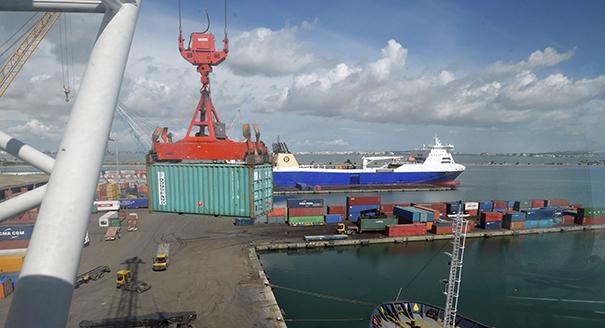Hamza Meddeb is a nonresident scholar at the Malcolm H. Kerr Carnegie Middle East Center, where his research focuses on economic reform, the political economy of conflicts, and border insecurity across the Middle East and North Africa. Recently, Meddeb published a paper titled “The Hidden Face of Informal Cross-Border Trade in Tunisia After 2011,” in which he examined how the informal trade, in other words trade not taxed or monitored by government, has continued to grow in Tunisia, regardless of the restrictions along the country’s land borders. Diwan interviewed Meddeb in early June to discuss his new paper.
Michael Young: You’ve just published “The Hidden Face of Informal Cross-Border Trade in Tunisia After 2011.” What is the main argument of your paper?
Hamza Meddeb: The argument is that despite the heavy-handed security measures adopted along Tunisia’s land borders, informal cross-border trade continues to thrive. The main reason for this is the rise in maritime corridors that have compensated for the slowdown of flows of goods going through land corridors. The dynamism of Tunisia’s maritime corridors owes much to the emergence of entrepreneurs who operate informally through trade networks connecting Tunisian and Asian ports, as well as to the informalization strategies adopted by some well-established firms to circumvent trade barriers and restrictions against trade. The rise of these informal networks reflects a growing trend, namely the progressive shift of Tunisia’s trade away from Europe and the rise of Turkey and China as new trading partners.
MY: What brought about the increased reliance on maritime trade?
HM: Maritime corridors have always been key pillars of transnational informal trade. The focus on land smuggling routes and the security challenges of illegal cross-border flows overshadowed the maritime networks, which are the dominant channel for the informal importation of goods. Under the former regime of president Zein al-Abedin bin Ali, maritime networks prospered for at least two reasons: The first was that those who imported goods by sea could trade higher volumes of goods than could be brought in by land, with opportunities to pay fewer taxes through misinvoicing.
The second was that maritime networks could benefit from overinvoicing imports as this facilitated capital flight in foreign currencies, which in return permitted the illicit accumulation of capital in such currencies, giving these networks more latitude to import larger quantities of goods. This allowed economic elites allied to the former regime to prosper and accumulate wealth.
Maritime networks thrived after the 2010–2011 uprising. Acts of terrorism in border regions led to the increased stigmatization of smugglers and cross-border traders, leading to a tightening of the security situation and controls on cross-border networks. The crackdown on land corridors benefited maritime corridors. Tightening security has been a crucial element in the reorganization of informal trade networks. Tunisian traders who used to import goods produced in China or Turkey over land routes from Libya and Algeria have come to rely, instead, on maritime networks and Tunisian ports.
MY: You note that the rise of informal networks has led to a shift in Tunisia’s trade away from Europe toward Turkey and China? What dynamics are at play?
HM: Maritime networks connect Tunisia to suppliers in Turkey, Dubai, and Asian countries. These networks allow for the transfer of money and goods. Increasingly, companies and entrepreneurs in the formal sector have adopted informal practices, whether through illegal money transfers or misinvoicing. These networks reflect the growing engagement of Turkey and China in Tunisia and the deeper penetration of Turkish and Chinese goods into Tunisian markets. Tunisia’s trade relations with China and Turkey in particular are on an upward trend. The increase in imports from China and Turkey—40 percent and 50 percent, respectively, between 2010 and 2019—corresponds to an almost equivalent decrease in imports from France and Italy—estimated at −28 percent and −2 percent, respectively.
MY: This shift toward greater reliance on the informal maritime trade has come at the expense of the cross-border informal land corridors. What have been the social implications of this, particularly for poorer areas that relied on such trade. And more generally what does this tell us about Tunisia’s economy today?
HM: The slowdown of land networks and the closing of land borders for more than a year because of the Covid-19 pandemic have heavily impacted border communities and economies, exacerbating social tensions in marginalized regions. The Al-Kamour protest movement that closed down the southern region of Tataouine for months in 2020 reflected the lack of economic opportunities in regions where the informal trade has always played a key role in maintaining social peace, acting as a safety valve.
The wave of emigration that has characterized the border regions is another sign of a systemic crisis in these regions. Libya’s stabilization could be a huge opportunity for Tunisia, especially for areas near the border, bringing back job opportunities and opening up these regions to business. There is a need to think strategically through the creation of economic zones. This could facilitate the establishment in border regions of companies that want to operate in Libya. Informal networks, whether operating on land or sea, show that a part of Tunisia’s economy is looking east to Libya, Turkey, and beyond to China. It is time to integrate these dynamics into the formal economy to exploit them to the maximum.






